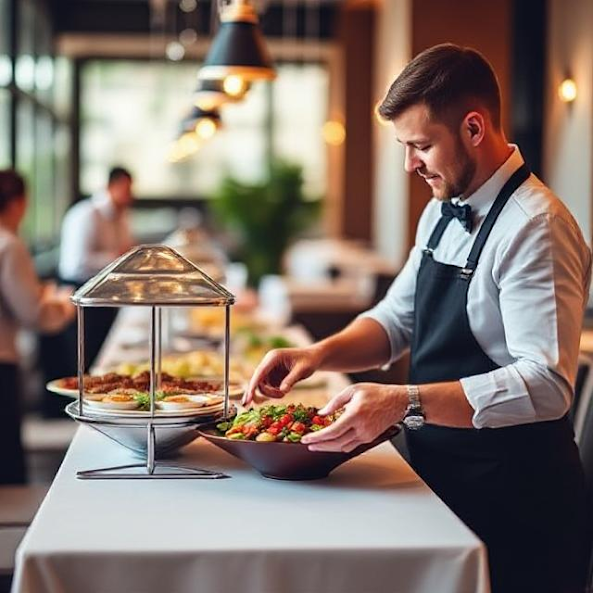Running a Successful Catering Service: Key Restaurant Tips
Running a Successful Catering Service requires excellent planning, quality food, and outstanding customer service. A well-structured menu, fresh ingredients, and attention to dietary preferences ensure client satisfaction. Efficient logistics, including proper food storage, timely delivery, and professional presentation, contribute to a seamless operation. Marketing through social media, word-of-mouth, and partnerships with event planners helps attract customers. Maintaining hygiene standards and obtaining necessary licenses build credibility. Adaptability to different event sizes and themes enhances business growth. Ultimately, running a successful catering service depends on reliability, creativity, and a commitment to delivering exceptional culinary experiences tailored to clients' needs.
Running a Successful Catering Service
Starting and managing a successful catering service requires a combination of culinary expertise, business acumen, and excellent customer service. Whether you're an established restaurant expanding into catering or a new entrepreneur, here’s a detailed guide to help you thrive in the catering industry.
1. Define Your Catering Niche
Before launching, identify your specialty to stand out in the market. Consider:
Type of Catering: Corporate events, weddings, social gatherings, or private parties.
Cuisine Focus: Italian, Asian, BBQ, vegan/vegetarian, or gourmet.
Service Style: Buffet, plated meals, food stations, or boxed lunches.
A well-defined niche helps in marketing and operational efficiency.
2. Create a Strong Business Plan
A solid business plan ensures long-term success. Key components include:
Market Research: Analyze competitors, target audience, and pricing.
Financial Plan: Budget for equipment, staff, ingredients, and marketing.
Operational Plan: Logistics, staffing, and workflow management.
Marketing Strategy: Branding, social media, and partnerships.
3. Obtain Necessary Licenses & Permits
Compliance with local regulations is crucial. Required permits may include:
Business License
Food Handler’s Permit
Health Department Certification
Liquor License (if serving alcohol)
Check with local authorities to ensure full compliance.
4. Invest in Quality Equipment & Supplies
Reliable equipment ensures smooth operations. Essentials include:
Cooking Equipment: Industrial ovens, stoves, chafing dishes, and warmers.
Serving Supplies: Plates, cutlery, glassware, and disposable options.
Transportation: Refrigerated vans for food safety.
Packaging: Eco-friendly containers for takeaway orders.
5. Build a Reliable Supplier Network
Partner with trusted vendors for:
Fresh Ingredients (local farms, wholesale markets)
Beverages & Alcohol (licensed distributors)
Equipment Rentals (tables, chairs, linens)
Strong supplier relationships ensure consistency and cost efficiency.
6. Develop a Scalable Menu
Your menu should be:
Diverse & Adaptable (options for dietary restrictions)
Cost-Effective (profitable yet competitively priced)
Seasonal & Trendy (incorporate fresh, in-demand ingredients)
Offer tasting sessions to clients before finalizing orders.
7. Hire & Train a Professional Team
A skilled team is vital for smooth service. Key roles include:
Chefs & Cooks (consistent food quality)
Servers & Bartenders (polished customer service)
Event Coordinators (client communication & logistics)
Invest in training for food safety, customer service, and crisis management.
8. Implement Efficient Logistics & Operations
Food Safety Protocols: Proper storage, handling, and transportation.
Timely Setup & Breakdown: Ensure events run smoothly.
Inventory Management: Track stock to avoid shortages or wastage.
Use catering management software for bookings, invoicing, and scheduling.
9. Market Your Catering Business Effectively
Attract clients through:
Website & SEO: Showcase menus, testimonials, and booking options.
Social Media: Instagram, Facebook, and TikTok for food visuals.
Networking: Partner with event planners, venues, and corporate clients.
Referral Programs: Incentivize past clients to recommend your service.
10. Deliver Exceptional Customer Service
Personalized Service: Tailor menus to client preferences.
Prompt Communication: Respond quickly to inquiries.
Follow-Up: Gather feedback for continuous improvement.
Happy clients lead to repeat business and referrals.
11. Manage Finances Wisely
Pricing Strategy: Cover costs while remaining competitive.
Invoicing & Payments: Clear terms (deposits, final payments).
Expense Tracking: Monitor food costs, labor, and overhead.
Use accounting software (QuickBooks, FreshBooks) for efficiency.
12. Adapt & Innovate
Stay ahead by:
Introducing New Menu Items (based on trends)
Offering Hybrid Services (meal prep, cooking classes)
Sustainability Practices (zero-waste catering, compostable packaging)
Conclusion
A successful catering business requires planning, quality service, and strong marketing. By focusing on your niche, maintaining high standards, and continuously improving, you can build a reputable and profitable catering service.







Comments
Post a Comment